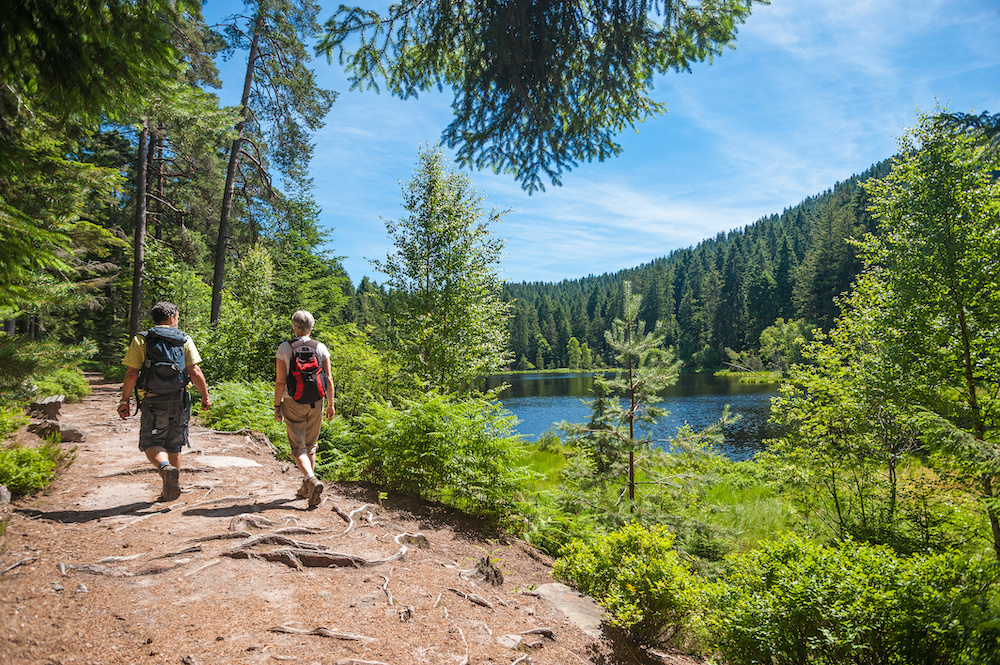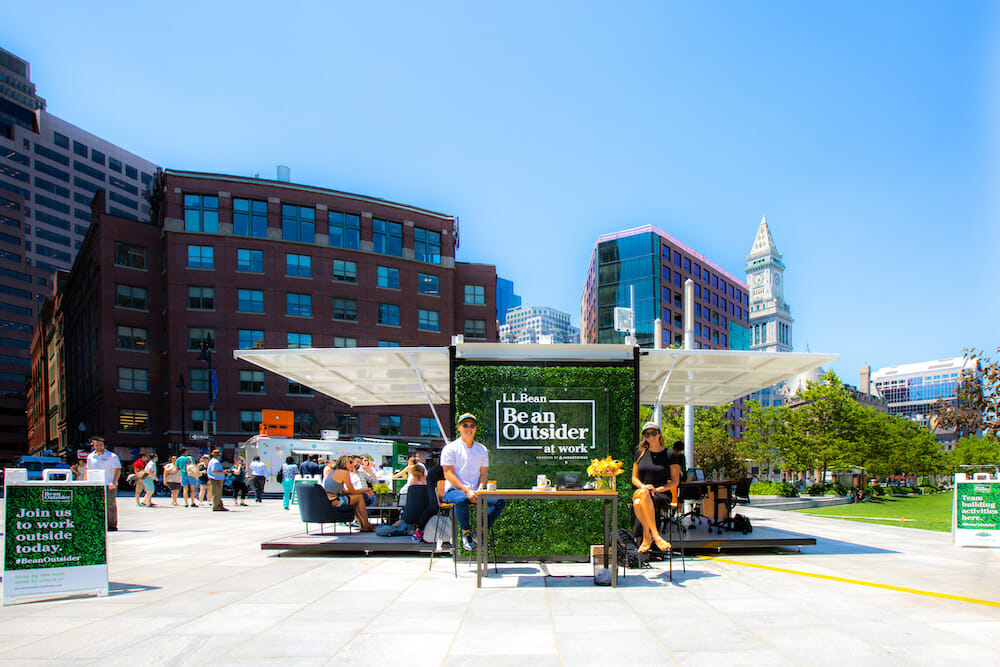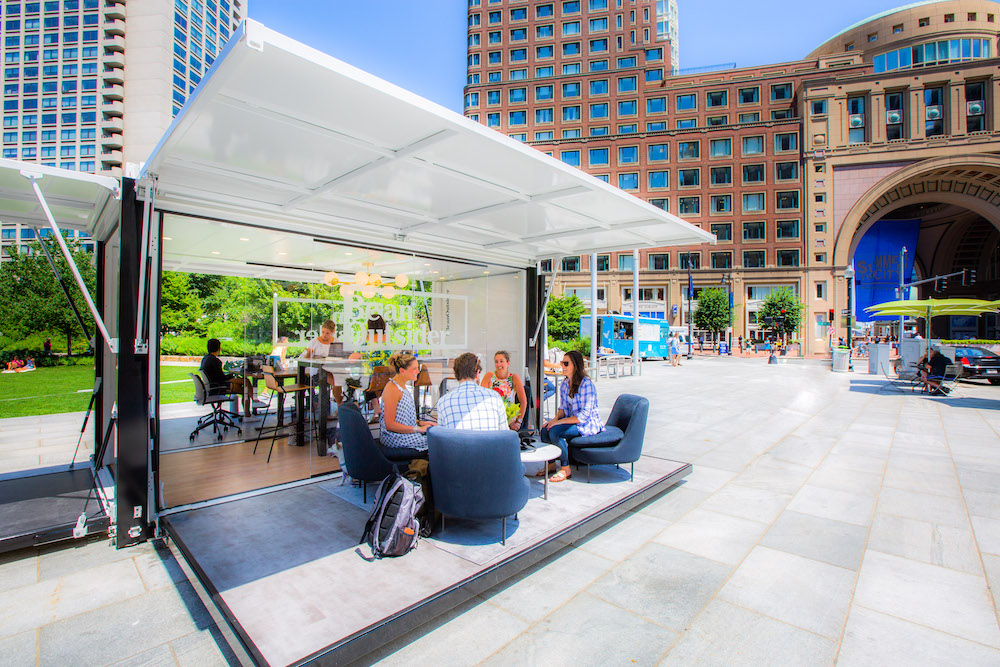Turning the Inside Out
The Workplace Meets Mother Nature
Remember back in college when you begged your professor to hold class in the quad under a tree? It turns out, you were onto something.

By Leigh Stringer, Workplace Research & Strategy, EYP
For most of human history, we spent our days outdoors. We hunted, gathered, scavenged, and farmed in the open air. But around 300 years ago (a tiny blip in our human timeline), we started spending most of our days working inside, specifically in factories. The industrial revolution introduced long hours, child labor, and some pretty frightening working conditions. Since then, major labor movements have put limits on the number of hours worked, environmental laws have improved air quality at work, business and building codes now protect most workers’ safety, and some workplaces are even designed to maximize ergonomics and well-being.
Yet despite major changes in the workplace for the better, including mobile technology that allows us to choose how, when, and where we work, we still continue to spend most of our time indoors. In fact, today, we spend roughly 92% of our day inside a building or in a vehicle (1). We can easily do part or all of our job in trains, planes, coffee shops, or hotels. But somehow working outside is a foreign concept.
It shouldn’t be. The term “biophilia” (reintroduced by the Harvard entomologist and environmentalist E.O. Wilson) refers to our preference as humans to be in and among nature. We simply thrive in it. Study after study shows that not only does being outside in nature improve our mental and physical wellbeing, it improves memory and focus, reduces mental fatigue and increases creativity. It helps us do our jobs better. The more biodiverse the environment we’re in, the better. Taking time to reconnect in nature establishes our body’s natural balance of sympathetic and parasympathetic responses, both preparing our bodies for mental activity (sympathetic) while reducing our stress and keeping us relaxed (parasympathetic).
Many organizations are trying to bring the outdoors in, designing interiors to include plants, sunlight (or artificial lighting that mimics sunlight), fresh air, and “natural analogues,” or surfaces and materials that mimic the natural environment. Research overwhelmingly shows that exposure to natural elements (even in small doses) while indoors is genuinely good for our mental and physical well-being. A recent Harvard study shows that subjects in offices exposed to real nature (plants and views outside), and those wearing virtual reality headsets with images of nature, both showed improved health and productivity outcomes over subjects who sat in environments with no exposure to nature (2). Another study by the University of Oregon found that simply providing employees with a view of trees and landscape reduced the amount of sick time they took per year (3).
But is being indoors with a view and a breath of fresh air enough? Research shows it may not be a substitute for actually being outside. In Japan, the practice of “forest bathing,” (shinrin-yoku) or taking immersive walks in nature, has been shown to decrease cortisol levels, sympathetic nervous activity, systolic blood pressure and heart rate (4). Studies have also discovered that certain forest trees emit organic compounds called phytoncides, and inhaling these compounds has been proven to decrease blood pressure, and improve immune system functions (5). In light of these benefits, the Japanese government has endorsed the practice and developed 48 “forest therapy” trails throughout the country.

What’s Keeping Work Inside
So if being outside is so good for us, what’s keeping us from going outdoors more, particularly at work, where we spend enormous parts of our day? I recently partnered with L.L.Bean to send a survey to 1,050 American “indoor” workers to find out. We found that 87% of those surveyed really enjoy the outdoors, but most rarely or never take time to work outside. 57% of those surveyed said they spend less than half an hour outside during the workday.
When we asked these indoor workers what kept them from going outdoors more, 65% said one of their biggest barriers was their job. Job inhibitors were wide-ranging and included issues with technology (no Wi-Fi or power, plus screen glare), organizational culture (they were afraid their boss would think they were goofing off), or their job required them to be indoors (nurses, retail employees, etc).
We found most respondents understand the benefits of nature to them personally, but not as many made the connection that being in nature could improve their performance at work. Most said the benefits to them working outdoors were improved mood, lowered stress levels, relaxation, increased health and wellness and increased happiness. Interestingly, if respondents said they already had an outdoor workspace available to them, they were much more likely to make the connection to productivity. Apparently seeing is believing.

First Outdoor Coworking Space
L.L.Bean partnered with Industrious (a coworking company) to test these findings, and in the Summer of 2018 we launched the firstever outdoor coworking space, pop-up style. It started in New York City’s Madison Square Park and moved to urban parks in Boston, Philadelphia, and Madison, Wisconsin. The outdoor office included a mix of work settings including meeting tables, soft seating, even a pedal table – with some spaces covered and some open to the sky. Industrious set up their online room reservation system to allow the public to book space outdoors and reserve a seat ahead of time.
A few thousand people took advantage of working outside at L.L.Bean’s outdoor areas, and participants widely reported the experience as refreshing and fun. The majority of participants surveyed said they were very likely to try to work outside more often. Here are a few notable reactions of participants who reserved one of the covered outdoor meeting rooms in Boston:
“Meeting in the outdoor co-working space was energizing and a refreshing departure. The experience felt like a break from the work day while also yielding a productive meeting.” — Sarah Brett, Senior Associate, Graphics & Branded Environments, Unispace
“It was a nice day to get outside, and to have a change of scenery, but I found the location to be a bit distracting. There were sirens because we were right near the fire station, horn honking from the traffic, dogs barking, and various street noises. This was a great place to have a quick check in meeting but I’m not sure it would be the most ideal setting for an intense collaborative work session.” — Meredith McCarthy, Senior Associate, Architect, Sasaki
Of course, those reactions were captured in mid-summer. When asked, “Would you be willing to work outdoors more in the wintertime?” the response by this same group was more mixed:
“Yes, if it’s not raining! Phone calls, face-to-face meetings that can be done while walking – either in the city or in local parks. In fact, this past winter I had some of the best meetings while walking and talking.” — Karin Sharav- Zalkind, Owner/ Designer, NoBox Studio
“Probably not, I don’t really like the cold! Maybe October/November but not December in Boston.” — Ashley Dunn, Director of Workplace, Dyer Brown Architects
L.L.Bean is not the only company experimenting with ways to bring the indoors out. There are many examples of organizations providing outdoor work environments for their employees including Amazon, Microsoft, Casper, Facebook, and Etsy. Whether they are taking advantage of green space nearby or real estate on top of their building, companies are thinking about how they recapture workspace.

Our Impact
Here are some of the key takeaways of working outdoors as a researcher and as a designer:
We can do more than we think outside.
People we surveyed claimed they felt more comfortable doing creative and relationship-based work outdoors vs. work involving technology and equipment. They could envision themselves having walking meetings, team brainstorm sessions, sitting on conference calls, or performing other hands-free activities outdoors. Activities requiring technical or detailed spreadsheet work were not as appealing. That said, I saw several people writing and answering emails in the L.L.Bean pop-up space. I think a surprising amount of work could get done outdoors and on a more regular basis. It just requires a little planning.
Working outdoors doesn’t require money.
The cost of piloting an outdoor workspace is very small and the net benefit to employee happiness and productivity is significant. It might just mean setting up a table, some chairs, and an umbrella. During the summer tour, many people reached out to L.L.Bean to see if the outdoor space could be set up in their city. Invariably our team would smile answer, “You don’t need us to work outdoors. Just open the door, and you’ve got it!”
Outdoor workplace can be seasonal.
We spoke with folks in Florida last June who were very resistant to working outside in the summer, but open to doing so more during the winter. Folks in Boston felt the opposite. I have started thinking about the workplace more dynamically. Where you work could vary by season or by climate zone. I mean, why should space be 100% occupiable 100% of the year? In fact, isn’t it boring if it doesn’t change?
Outdoor spaces are not one-size-fits-all.
Sometimes, when we asked people “hypothetically” what they thought about working outside, they answered like we were asking them to sit on a chair in the middle of a baseball field, completely exposed to the elements. The solution for good outdoor work environment is probably nothing like that. The space might be covered, use glass to block wind, have fans, be wired or Wi-Fi enabled. I was in London this summer and saw an outdoor workspace filled with bean bag chairs. Really, the sky’s the limit.
We know being outside is good for us, but we are still learning why.
Early forest bathing research in Japan tells us that even a small amount of outdoor exposure is good, and that the benefits can be long lasting. But how much exposure to the outdoors is ideal? What about the quality of the outdoor space? Forest bathing studies are often conducted in lush natural environments full of cypress and pine trees. Does working outside in an urban setting have the same physical and psychological effect? Interestingly, I noticed that after working outside for two days straight in Madison Square Park, my brain started to filter out ambulance sirens and filter in birdsong, leaves rustling, and other pleasant sounds. This filtering, or “cognitive inhibition” in my brain, allowed me to sort out what I didn’t want to hear, and I could focus better. There is still a lot we have to learn.


